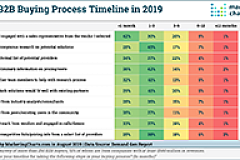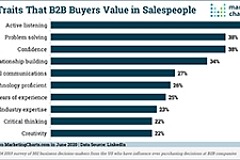 Retailers can boost revenues and profits by utilizing great selling techniques. In this article five retail experts offer their top 14 tactics for dealing more productively with customers and making cash registers ring a merry tune.
Retailers can boost revenues and profits by utilizing great selling techniques. In this article five retail experts offer their top 14 tactics for dealing more productively with customers and making cash registers ring a merry tune.
You’ve stocked your shelves. Hired your staff. Placed your ads. Now, how can you get the most return from your retail investment?
Improve your selling techniques. Dealing more profitably with customers, attracting more of them, and boosting your average ticket, have become more important than ever with the growing competition from the Internet and rival stores.
“The ’80s are over,” says Bob Phibbs, a retail consultant based in Coxsackie, New York. “No longer can retailers count on customers crowding into retail showrooms. [quotesright]Today there are just too many places to buy too much of the same thing. [quotesright] Fewer bodies are walking in the door, so you have to do better with those that do.”
Ready to start? Here are 14 top “sales tactics” from four veteran retail experts.
Tip #1: Get out on the sales floor
“Get out from behind the sales counter and engage with customers,” says Phibbs. Meeting and greeting people is the foremost way to illustrate a “customer-first” philosophy. “[quotesright]Too many salespeople act like princes and princesses[/quotesright] sitting safely behind their moats.”
Bonus tip: Engage more closely with customers by reducing the size of your sales counters. “The more space between customers and employees,” says Phibbs, “the less likely people will forge relationships.”
Tip #2: Start a dialog with the customer
[quotesright]Ditch the standard sales pitch[/quotesright] in favor of a productive conversation. “Instead of trying to sell people something you have too much of, express genuine curiosity about why they came into your store,” says Shep Hyken, a St. Louis-based customer service consultant (hyken.com). He suggests an opener like this: “Welcome to the ABC Store. Thanks for coming in. What can I help you find today?”
Bonus tip: Introduce yourself by name and ask for the customer’s name. “There is nothing more valuable to the customer than their name,” says John Tschohl, president of Service Quality Institute, Minneapolis. “So remember it and greet the customer personally on their next visit.”
Tip #3: Stay with the customer
When customers tell you what item they want, don’t just point the way. Walk them to the location while engaging in conversation.
Tschohl suggests sparking a dialog with a question such as one of these: “What will you be using this item for?” or “Is there a special reason you are purchasing this item?” The answer may well lead to a conversation that uncovers additional customer needs. “[quotesright]A great sales person asks questions that uncover problems customers want to solve, [/quotesright]” says Tschohl. “Solving those problems will often require additional merchandise and services.”
Bonus tip: Encourage customers to handle the merchandise. “Studies have shown that when a person owns something it has a higher perceived value,” says Doug Fleener, president of Dynamic Experiences Group, a consultancy in Lexington, Massachusetts. “And if a person physically holds or tries a product, it increases the perception of ownership.”
Tip #4: Let employees say ‘yes’
When customers ask a favor – say to take advantage of a sale that ended yesterday – too many stores make them cool their heels while the staff seeks management permission. You can do better. “[quotesright]Give your employees the power to say ‘yes,’ [/quotesright]” says Hyken.
Certainly, you need to educate employees about where the line in the sand is so they don’t give away the store. But the requisite time and effort pays dividends, says Hyken: “When customers experience less friction in the shopping process they return to the store because they know your employees are empowered to make great decisions.”
Bonus tip: Educate your employees on everything about your merchandise. “When a customer asks ‘What’s the difference between x and y?’ your employee should have an answer,” says Tschohl. “A customer can tell within a few seconds whether or not an employee knows the store’s merchandise.”
Tip #5: Offer a choice
“When possible show the customer two or three products at various price points,” says Fleener. “Not one after another, but side by side.” Reason? “[quotesright]Studies have shown that the typical shopper makes two decisions. [/quotesright] The first is ‘Am I going to buy something?’ and the second is ‘What will I buy?’”
When you show multiple items, says Fleener, many customers automatically give themselves permission to make a decision between products rather than whether to buy at all. Also, a customer presented with choices gains confidence that a retailer has the right solution for them.
Bonus tip: “Don’t offer more than three choices,” cautions Fleener. “That can be overwhelming.”
[sidebarright225]
How Good a Sales Person Are You?
Are you a sales “super star”? Find out by taking this quiz. Score 10 points for every “yes.”
1. Do you spend most of your time engaging with customers on the sales floor?
2. Do you always approach customers with a helpful demeanor, and ask what you can help them find?
3. Do you walk with customers to the requested merchandise location rather than point the way?
4. Does your staff feel free to say “yes” to customer requests without asking permission?
5. Do you offer multiple price points and discuss the higher priced item first?
6. Do you display high margin items in the store entrance area and the area to the right?
7. Do you position demand merchandise in the back and impulse items at check out?
8. Do you display related items in adjacent positions?
9. Have you posted interpretive signs that solve customer problems?
10. Have you brightened your walls and spotlighted key displays?
Score 10 points for each “yes.” Then total them up. How did you do? From 80-100: You are a sales “super star.” Keep looking for ways to improve. 50-70: Your store is a typical, middling operation. Polish things up and watch your revenues soar. Below 50: Very poor. Be careful: Make changes before you incur an erosion of sales from the Internet and other retailers.
[/sidebarright225]
Tip #6: Discuss the best merchandise first
Here’s a corollary to the previous tip. “Always talk about the best item first,” says Fleener. “This allows you to ‘sell down,’ rather than up. And when you are selling down you almost always get the higher sale.” Why? “Starting with the top of the line communicates respect for the customer,” says Fleener. “And studies show it also tends to motivate the customer to purchase that item.”
“I call this the ‘butcher rule,’” explains Fleener. “[quotesright]If you go to a butcher and ask what’s good, he will always start with prime rib, not chicken. [/quotesright]”
Bonus tip: “Cross selling,” or suggesting merchandise related to requested items, can boost your average ticket while helping customers save time and avoid return trips. “When you ask the right questions you are doing customers a service rather than just trying to sell them more stuff,” says Hyken.
Tip #7: Promote the entrance area
“Make sure there is always something exciting displayed in the area just inside the front door,” says Tom Shay, a consultant based in St. Petersburg, Florida. The reason: Your showroom entrance gets more customer traffic than any other location. “Try changing what’s displayed there every two or three days.”
Bonus tip: Because most browsers tend to turn right after entering a store, Shay also recommends displaying high-margin items, changed every few days, in that part of the showroom.
Tip #8: Position demand merchandise in back
Are there items which your customers come to your store specifically to buy? [quotesright]Position those in the back of the store, [/quotesright] says Shay. “You want people to walk through your store past your other displays to stimulate more sales.”
Bonus tip: Another smart move is to display popular demand items midway down each aisle. Again, the idea is to pull the public through your entire array of displayed merchandise.
Tip #9: Display impulse items at checkout
Your checkout counter gets lots of customer traffic, and [quotesright]when people pull out their wallets[/quotesright] it’s a great time to promote additional impulse sales. Display small-ticket, high-margin items next to your cash register.
Bonus tip: And right beside those impulse items have a box for business cards and a sign-up sheet to collect names for your store newsletter.
Tip #10: Change displays often
Reposition your departments every few months. “Moving around your store fixtures makes old stuff look new again,” says Phibbs. “That creates energy and stimulates customer interest.”
Bonus tip: Retool your fixtures by altering shelf patterns and breaking up long rows into shorter sections with highlighted displays. “You can’t design a small store like a supermarket with long rows of shelves,” says Shay. “People will say ‘this is starting to look old.’”
Tip #11: Improve your adjacencies
“Display related merchandise in adjacent positions to encourage tie-in sales,” says Hyken. Over time, as new departments and items are added, [quotesright]it’s easy to let this principle slide. [/quotesright] But when related merchandise is displayed at distant showroom locations, customers can easily get confused, frustrated and angry.
Repeated questions from customers about the location of a certain item can indicate the need for repositioning.
Bonus tip: Mount overhead signs that help direct customers to the most popular departments.
Tip #12: Post interpretive signs
Communicate value by posting interpretive signs that explain how merchandise can solve customer problems, suggests Phibbs. [quotesright]This is particularly effective for high-ticket items. [/quotesright] “Stimulate more sales emphasize the ‘bang’ (the benefit to the customer) rather than the ‘buck’ (the discount),” he says.
Bonus tip: Mount a television screen on your wall and show videos of customers actually using your merchandise, suggests Phibbs. “Ask permission to use the customers’ names and cities.”
Tip #13: Brighten your walls
“Customers respond favorably to freshly painted walls,” says Shay, who suggests trying new, bright colors. “Even if people don’t know exactly what has changed, [quotesright]they will take a new interest in your store. [/quotesright]” Shay also suggests adding graphics to your walls. Geometric patterns of circles, triangles, and squares can create an attractive backdrop.
Bonus tip: Approach a local art gallery with an offer to display some of their work for a few days, says Shay. “Sending postcards inviting the public to your temporary art show will attract people you never saw before.”
Tip #14: Spotlight your displays
Now you have a great store. Add some highlights! “Mount spotlights to draw customers to your most important displays,” says Phibbs. “Try positioning small desk lights to [quotesright]create tiny areas of discovery. [/quotesright]” Strategically placed lights can make your whole store “pop” with excitement.
Bonus tip: “Visit some specialty lighting stores for ideas on how to use fixtures for the best results,” says Phibbs.
Inspire loyalty
Each of the above 14 tips reflects a common principle: A customer-centric attitude to selling. Initiating great conversations, creating thoughtful displays, and brightening the showroom all work together to solve the problems and improve the lives of customers.
“Great sales techniques are not about manipulation but about being helpful and building a relationship that is so good that price becomes less relevant,” says Hyken.
“Customers will buy more frequently and spend more money when they trust a retailer. It’s not just about the sale, it’s about building long-term relationships that bring more revenues and profits.”
Need to upgrade the sales skills of your staff and discover even more ways to boost your sales and bottom line? We are the experts in sales training and improving business results. Never an obligation. Call: USA: 877.433.6225 or Email: feedback@focalpointcoaching.com














